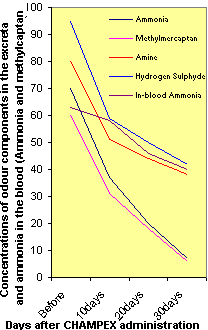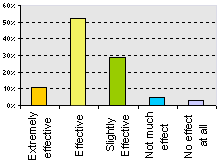|
|
 |
|
Effects of Champex, as proven by In-Vitro and In-Vivo tests
Section One - Suppressive effect on foul breath and Faecal Odour.
1-1 Deodorizing effects on the odour-causing chemical, methyl mercaptan, using the GC method
Purpose
Methyl mercaptan is widely recognized as a common component of mouth odours. The purpose of the test was to determine the deodorizing effects of various concentrations of Champex on methyl mercaptan, at a level of 0.5 ppm, which is 250 times the minimum detectable level by the human nose (0.002 ppm).
Method
Accurately weigh 1, 2, 3, 5 and 10 mg of Champex, then dissolve each quantity in 3 ml of distilled water and adjust the pH of the solutions using NaOH to 6.5. Immediately after pouring each solution into a vial with a 125ml capacity,inject methyl mercaptan standard into the vial to obtain a 0.5 ppm solution. Prepare other vials containing distilled water and methyl mercaptan at 0.5 ppm to serve as controls.
|
Analytical Equipment
1) Model : GC-14B(SHIMAZU)
2) Column : Polyphenyl ether
(5 rings) 10% Shimalite
TPA 60-80 mesh
Glass column:3.1 x 3.2 mm Ř
3) Column Temp : 65C
4) Carrier gas : N2 (nitrogen gas)
5) Detector : FPD (S)
This detector selectively detects sulphur, enabling measurement of lower levels of sulphur than GCs of conventional capacity. The detected values are processed by computer.
Results
Comparing the results obtained with the distilled water control and with the solution containing Champex at 1 mg, in the distilled water solution, 0.41 ppm of methyl mercaptan was still detected 75 minutes after injection of the methyl mercaptan (deodorizing rate of the distilled water was 14%). In the solution containing Champex, however, the concentration of methylmercpatan registered nil 75 minutes after injection (deodorizing rate of 1m Champex was 100%). Furthermore, it was noted that with increased ratios of Champex, the time required to deodorize methyl mercaptan was much reduced.
|
Deodorant Effect on a causative component of mouth odour, methyl mercaptan, using GC method
| Test solutions | Immediately after | 15min. | 30min. | 45min | 60min. | 75min. |
| 1mg/3ml distilled water | 0.35 | 0.23 | 0.18 | 0.14 | 0.12 | 0 |
| 2mg/3ml distilled water | 0.33 | 0.21 | 0.15 | 0 | 0 | 0 |
| 3mg/3ml distilled water | 0.31 | 0.20 | 0.13 | 0 | 0 | 0 |
| 5mg/3ml distilled water | 0.28 | 0 | 0 | 0 | 0 | 0 |
| 10mg/3ml distilled water | 0.20 | 0 | 0 | 0 | 0 | 0 |
| 3ml distilled water | 0.44 | 0.44 | 0.43 | 0.42 | 0.42 | 0.41 |
| Methylmer- captan alone | 0.48 | 0.47 | 0.46 | 0.45 | 0.45 | 0.44 |
1-2 Deodorizing effect on odours in the mouth cavity (mouth odours) following ingestion of fresh garlic by GC method
Purpose
The deodorizing effects of Champex on odours in the mouth cavity (mouth odours) following ingestion of fresh garlic were compared with the effects of distilled water.
Test Method
Method (1) Two point five (2.5) grams of grated fresh garlic was mixed in 20ml of water and left to sit for 5 minutes. This mixture was then given to the testees (*1), who kept it in their mouths for 1 minute before disgorging it. Odours in the mouth cavity were then measured according to Method (2). Five (5) minutes after disgorging the garlic/water mixture, panelists in the treated group rinsed out their mouth 3 times with a total of 50ml of distilled water containing 100mg of BX100 FPD-S (pH adjusted to 6.5 to 7.2), while those in the control group rinsed with 50ml of distilled water. (*2) The average concentrations of odours (the average of the five testees) were then plotted on graphs as concentrations.
|
Method (2) Five (5) minutes after rinsing, and after each testee had held a tube (*3) in the mouth for 1 minute while breathing through the nose, 5 ml of breath was drawn from the mouth cavity of each testee using a gas-tight measuring syringe inserted into the end of a tube. The breath samples were then analyzed using a Gas Chromatograph (*4) to measure odour concentrations. Measured values were plotted on graphs as concentrations 10 minutes after panelists ingested the garlic mixture. The procedure described in (3) above was repeated 30 minutes later. Measured values were plotted on graphs as concentrations 40 minutes after the garlic mixture was ingested. (*5)
|
(*1): Ages of the testees were as listed below.
Treated group: 2 females were in their twenties and 1 male was in his fifties
Control group: 3 females were in their twenties
(*2): Each testee continued to breathe through the nose for a period after disgorging the garlic mixture, in order to prevent odours in the mouth cavity from dissipating.
(*3): A silicon tube 7mm in diameter and 5 cm in length was attached to the gas chromatograph using an injection nozzle (original RICOM design).
(*4): GC apparatus and condition
1) Gas chromatograph: GC-14A (SHIMAZU made)
2) Colum Polyphenyl ether (5 rings)×10%
3) Detecter FPD(S)
(*5): Test result is shown by the averages of both treated and control group.
|
RESULTS
Five (5) components of the garlic were measured immediately after the garlic mixture was ingested. Among these, methyl mercaptan and allyl mercaptan showed very high concentrations of 12.5747 ppm and 13.3007 ppm, respectively. Allylmethylsulfide was detected at 2.3585 ppm and dimethylsulfide or dimethyldisulfide were scarcely detected.
Testees in the treated group rinsed out their mouth with Champex solution after ingesting the garlic mixture, while testees in the control group rinsed with distilled water in the same manner. In the treated group, 10 minutes after ingestion of the garlic mixture, concentrations of methyl mercaptan and allylmeraptan had decreased substantially to 1.4793 ppm and 1.6830 ppm, respectively, and no traces of allylmethylsulfide were detected whatsoever. In the control group, on the other hand, 10 minutes after ingestion of the garlic mixture concentrations of methyl mercaptan, allyl mercaptan and allylmethylsulfide were at 5.4433 ppm, 6.2910 ppm and 0.2080 ppm, respectively - concentrations that were noticeably higher than those obtained from the treated group. The above results clearly establish that following the ingestion of a garlic mixture, odours in the mouth cavity were deodorized much better with a mouthwash containing a Champex solution than with distilled water.
|
1-3 Effect on the Reduction of faecal Odour Components (Results presented to the 36th Congress of the Tohoku Clinical & Hygienic Examination Society)
Purpose
To examine the effective reduction of faecal odour components following a 30-day oral administration of Champex at a daily dose of 1gram to 14 aged in-patients at Tsuchizaki Hospital in Akita City, Japan.
Test Method
faecal samples from each in-patient were collected in polyethylene bags with a 1 liter capacity. Concentrations of chemical gases in the excreta (ammonia, methyl mercaptan, hydrogen sulfide, and amine) were measured using a Kitagawa gas detector, while further ammonia concentrations in the blood were measured using the Fuji-Okuda modified method prior to the initial administration of Champex. During the Champex administration trial, measurements were repeated 3 times at 10-day intervals to collect data on successive changes in the concentration of chemicals.
Results
A remarkable reduction in gas generation in excreta was observed. Furthermore, the results of ammonia concentration in the blood indicated an apparent correlation with the decreased concentration in the excreta. From an average of 93µg/dl before the administration of Champex, it decreased by 52% to 45µg/dl. This study provides clear evidence that reducing concentrations of ammonia in the excreta may lead to reduced concentrations of ammonia in the blood.
|

*The above chart shows the average concentrations of excreta gases and ammonia in the blood of 14 inpatients before and after the administration of Champex. The blood ammonia concentrations were converted and expressed in terms of PPM for inclusion in this chart.
|
1-4 Deodorizing effects on odours in the mouth cavity (mouth odours) following the ingestion of barbecued meats
Outline of the test
An organoleptic test was conducted, involving 63 female college students. Following a meal of barbecued garlic-seasoned meat, each participant took a candy containing Champex at 0.125%.
Results
According to a questionnaire survey conducted in regards to the participants’ perceived expiration of foul odours, 58 out of 63 participants (92.1%) responded that Champex was effective in alleviating mouth odours. These results attest to the significant deodorizing capabilities of Champex with a protein rich meal.
Results of an organoleptic evaluation survey of 63 female college students
The effects of ingesting candy containing Champex after a garlic-seasoned meal

|
| Evaluation | No.
of participants | Percent |
| 1 | Extremely
effective | 7 | 11.1 |
| 2 | Effective | 33 | 52.4 |
| 3 | Slightly
Effective | 18 | 28.6 |
| 4 | Not
much effect | 3 | 4.8 |
| 5 | No
effect at all | 2 | 3.1 |
| Total | 63 | 100.0 |
|
| |
|
|